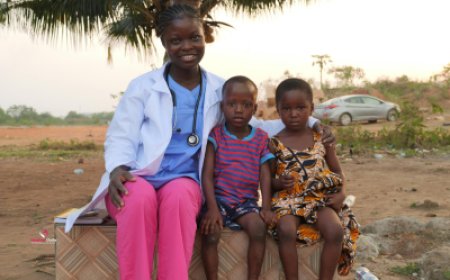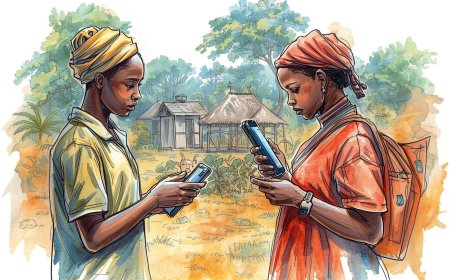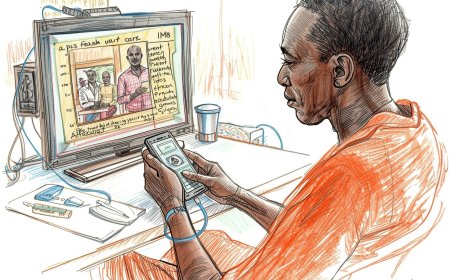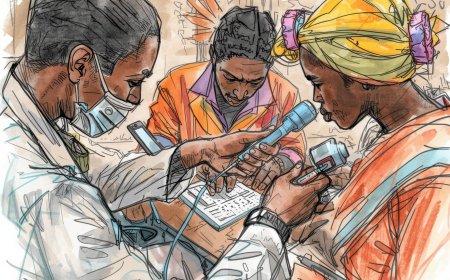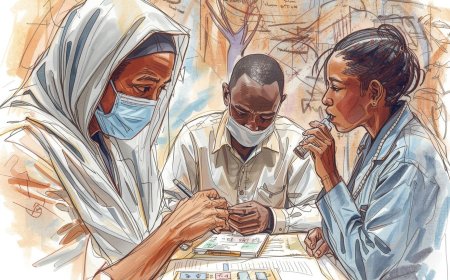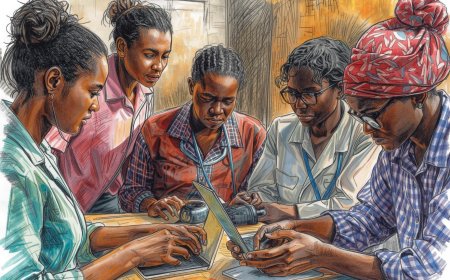A Strategic Guide to Achieving Product-Market Fit for Digital Health Apps in Africa
A comprehensive framework for health-tech innovators on achieving product-market fit (PMF) for digital health apps in Africa. This guide covers the dual-track validation process of building a Minimum Viable Product (MVP) for low-bandwidth realities and securing Minimum Viable Relationships (MVR) within the local ecosystem. Learn how to navigate infrastructural constraints, socio-cultural dynamics, and apply context-aware metrics to build digital health solutions that are trusted, adopted, and integrated into African healthcare.

Executive Summary
Achieving product-market fit (PMF) is the seminal milestone for any startup, signifying the point where a product satisfies a strong market demand. For digital health applications targeting the African continent, this journey is uniquely complex, shaped by a landscape of urgent healthcare needs, distinctive infrastructural constraints, and deeply embedded socio-cultural dynamics. This report provides a comprehensive framework for health-tech innovators to navigate this terrain, moving from initial hypothesis to validated, scalable impact. The analysis demonstrates that PMF in Africa is not a singular achievement but a dual-track validation process. It requires building a functionally viable product—a Minimum Viable Product (MVP) engineered for the realities of low bandwidth and diverse user literacy—while simultaneously securing relational legitimacy within the local ecosystem, a concept termed Minimum Viable Relationships (MVR). Standard metrics for measuring PMF must be critically re-contextualized; engagement cannot be measured by session times alone when offline functionality is paramount, and user satisfaction scores must be interpreted with an awareness of the limited alternatives available. By integrating Human-Centered Design (HCD), the dual MVP/MVR framework, and context-aware measurement, this guide offers a strategic compass for building digital health solutions that are not only wanted but are also trusted, adopted, and integrated into the fabric of African healthcare.
Section 1: Deconstructing Product-Market Fit: Universal Principles for Health-Tech Innovation
1.1 Defining the Elusive Goal: What Product-Market Fit Means for a Digital Health App
Product-market fit (PMF) is fundamentally the degree to which a product successfully satisfies a strong market demand.1 Coined and popularized by entrepreneurs Marc Andreessen and Andy Rachleff, it is most effectively defined as "being in a good market with a product that can satisfy that market".2 For a digital health app, this means creating a solution that a specific customer segment not only uses but finds indispensable—a "unique product offering that people desperately want".1
Achieving PMF is the critical inflection point where a startup transitions from a state of resource-constrained survival to one of sustainable growth.5 It is evidenced by a confluence of positive signals: organic growth through word-of-mouth, high customer retention, strong engagement metrics, and a clear economic viability where the customer lifetime value ($LTV$) significantly exceeds the customer acquisition cost ($CAC$).5 It is crucial to recognize that PMF is not a static, one-time achievement but a continuous process of alignment with a constantly shifting market.1 It exists on a spectrum; a product can have weak or strong PMF, and this can change over time as customer needs and competitive landscapes evolve.7
The concept of a "desperate" customer need is particularly resonant within the African health-tech space. The continent's healthcare landscape is defined by profound, systemic challenges that create a market of inherently urgent needs. Africa bears 25% of the global disease burden but is home to only 3% of the world's healthcare workers.9 Most nations allocate less than 5% of their GDP to healthcare, leading to under-resourced facilities and chronic shortages.9 Furthermore, an estimated 408.6 million people in sub-Saharan Africa lacked access to healthcare services as of 2020.10 In this context, a digital health app is often not a tool of convenience but a bridge over a fundamental gap in access or quality. While an app that merely digitizes a functioning process in a developed market might be a "nice-to-have," a solution that provides a rural patient with their first-ever consultation with a specialist, or ensures a clinic has a reliable supply of essential medicine, becomes a "must-have." This elevates the validation challenge from simply solving a problem to addressing a critical, life-impacting deficiency.
1.2 The Value Hypothesis: Articulating Your Core Bet
The journey toward PMF begins with a clear and testable "value hypothesis." This concept, articulated by Andy Rachleff, posits that a startup must define its core bet on why a customer will use its product.3 This hypothesis is composed of three essential elements:
-
The Product/Features: What specific solution needs to be built?
-
The Target Audience: Who is the specific group of people that will care about this solution?
-
The Business Model: What is the mechanism (e.g., pricing, distribution) that will entice customers to adopt and pay for the solution? 3
PMF is the moment this value hypothesis is proven true in the real world—when the product, market, and business model align to create a solution so compelling that customers cannot imagine reverting to their previous way of doing things.3 The process of validation is an iterative journey of testing and refining this core hypothesis until it resonates powerfully with the target market.
1.3 Foundational Methodologies: Integrating Lean, Agile, and Iterative Principles
To systematically test and refine the value hypothesis, successful health-tech innovators employ a synthesis of modern product development methodologies. These frameworks provide the structure to navigate uncertainty, reduce waste, and accelerate learning.
The Lean Startup methodology, popularized by Eric Ries, provides the guiding philosophy. It reframes a startup as an experiment designed to answer a core question: "Can we build a sustainable business around this product?".11 Its central mechanism is the build-measure-learn feedback loop, which prioritizes speed and validated learning. Instead of building a "perfect" product in isolation, the goal is to develop a Minimum Viable Product (MVP) to begin the learning process as quickly as possible, measure customer response with actionable metrics, and then decide whether to persevere with the current strategy or pivot.11 In the high-stakes, highly regulated digital health sector, this approach is vital for de-risking innovation before committing significant resources.12
Agile development offers the practical toolkit for executing this philosophy. Agile breaks down large, complex projects into small, manageable cycles called "sprints".13 This iterative development process, which involves repeated cycles of designing, building, and testing small increments of the product, is perfectly suited for the dynamic healthcare environment.13 By fostering close collaboration between cross-functional teams (including clinicians, engineers, and patients) and prioritizing patient-centered design, Agile ensures that the product evolves in direct response to real-world feedback, regulatory shifts, and clinical needs.13 This continuous refinement loop allows teams to build software that is not only technically sound but also deeply integrated into the complex workflows of healthcare delivery.
Section 2: The African Digital Health Landscape: A Market of Urgent Needs and Unique Constraints
2.1 Market Overview: Sizing the Opportunity
The digital health market in Africa is not just emerging; it is accelerating at a remarkable pace, driven by the profound need to bridge systemic healthcare gaps. Valued at approximately $3.8 billion in 2023, the market is projected to expand at a compound annual growth rate (CAGR) of 23.4%, reaching an estimated $16.6 billion by 2030.10 This high-growth environment is characterized by a significant degree of innovation, as startups leverage technology to create novel solutions for remote diagnosis, monitoring, and treatment.10
Despite a global venture capital downturn, the African health-tech sector has demonstrated resilience. While overall funding has moderated, investors show a continued appetite for the sector, with a notable focus on seed-stage deals and strategic partnerships.18 This indicates a healthy pipeline of early-stage innovation. However, this investment is not evenly distributed. A significant concentration of funding—around 83% in the first quarter of 2025—is directed toward the "Big Four" tech hubs: Kenya, Nigeria, South Africa, and Egypt, suggesting that startups in other regions may face greater challenges in securing capital.18
Table 1: Comparative Analysis of Key African Health-Tech Markets
|
Country |
Population (2024 Est.) |
Mobile Internet Penetration (2024) |
Smartphone Adoption (2024) |
Primary Healthcare Challenge |
Digital Health Market Size (2023 Est.) |
Regulatory Maturity |
|
Nigeria |
~230 Million |
28% 19 |
45% 19 |
Fragmented federal system, severe doctor shortage (0.4/1,000) 10 |
High |
Developing (Digital Health Bill 2025) 20 |
|
Kenya |
~56 Million |
33% 19 |
54% 19 |
Urban-rural disparity, infrastructure gaps 9 |
High |
Established (Digital Health Act 2023) 21 |
|
South Africa |
~61 Million |
77% (Southern Africa) 19 |
79% (Southern Africa) 19 |
Two-tiered, highly unequal system (public vs. private) 22 |
High |
Evolving (HTA for NHI) 23 |
2.2 The Problem Space: Africa's Core Healthcare Challenges as a Foundation for Innovation
The opportunities in African digital health are directly shaped by the continent's most pressing healthcare challenges. These systemic issues are not merely background context; they are the specific, high-value problems that digital solutions must address to find a market. Key challenges include:
-
Underfunding and Fragmentation: Most African nations allocate less than 5% of their GDP to healthcare, far below the 15% target of the Abuja Declaration. This results in underdeveloped infrastructure, chronic medicine shortages, and fragmented service delivery, with significant disparities between urban and rural areas.9
-
Human Resource Crisis: The continent has an alarming shortage of healthcare professionals. With only 3% of the world's health workers, Africa carries 25% of the global disease burden. This is exacerbated by a "brain drain" of trained professionals migrating to higher-paying countries.9
-
The Double Burden of Disease: Health systems are strained by the need to combat infectious diseases like malaria and HIV/AIDS while also facing a rapid rise in non-communicable diseases (NCDs) such as diabetes and hypertension, driven by urbanization and lifestyle changes.9 NCDs now account for over 37% of deaths in sub-Saharan Africa.9
-
Infrastructure and Supply Chain Deficiencies: A lack of hospitals, diagnostic centers, and reliable medical supply chains hampers effective care delivery. Many countries import over 90% of their medicines, making them highly vulnerable to global supply disruptions.9
2.3 The Infrastructure Reality: The Mobile-First Imperative and the "Usage Gap"
The digital landscape in Africa presents a critical paradox that must inform any product strategy. On one hand, mobile connectivity is the cornerstone of the continent's digital economy.25 Mobile internet penetration is projected to reach 33% by 2030, with a rapid migration from 2G/3G to 4G and 5G networks underway.19 This suggests a growing market for sophisticated, data-rich mobile applications.
However, this growth story is tempered by a persistent "usage gap." Despite expanding network coverage, GSMA projects that nearly half of all Africans will not use mobile services by 2030, and 77% will remain unconnected to the mobile internet.19 This gap is driven by significant barriers, primarily the high cost of internet-enabled handsets—which can amount to 87% of a person's monthly income for the poorest 20%—and low digital literacy.19 Furthermore, a significant portion of mobile connections in sub-Saharan Africa, over 40%, still rely on 2G networks.27
This creates a bifurcated market where a "mobile-first" strategy cannot be synonymous with a "smartphone-app-first" strategy. While a growing segment of urban, affluent users can support modern apps, a vast potential market remains accessible only through technologies that function on basic feature phones and in low-bandwidth environments. True market validation, therefore, requires a multi-channel approach from the outset. A viable product strategy must consider the lowest common denominator of access, prioritizing technologies like USSD (Unstructured Supplementary Service Data), SMS, Progressive Web Apps (PWAs), and lightweight, offline-first native applications as core components of the Minimum Viable Product, not as afterthoughts for future expansion.27
2.4 The Human and Institutional Element: Navigating Diversity and System Fragmentation
Beyond technical infrastructure, the path to PMF is shaped by human and institutional complexities. Africa is a continent of immense diversity, home to over 2,000 languages and a vast array of cultural norms and values.31 This reality demands a move away from Eurocentric, "one-size-fits-all" digital health solutions toward approaches that are co-created with local communities and are deeply sensitive to their context.33
The institutional landscape is equally complex. The digital health sector is often a fragmented patchwork of stand-alone pilot projects, frequently driven by external donor funding.33 These initiatives, while well-intentioned, often result in siloed data systems that are not interoperable with each other or with national health information systems.33 A new digital health app entering this environment risks becoming another isolated silo, which severely limits its potential for scalability and long-term systemic impact, even if its end-users find it valuable.
This context expands the definition of product-market fit beyond a simple user-product relationship to include ecosystem-product fit. A critical part of validating a health-tech app's value hypothesis involves demonstrating how it will integrate with or complement the existing health ecosystem. This includes aligning with national health strategies, ensuring interoperability with government health information systems, and forming strategic partnerships with key stakeholders like ministries of health, mobile network operators (MNOs), and non-governmental organizations (NGOs).35 These partnerships are not merely growth tactics to be pursued after PMF is achieved; they are essential components of the validation process itself, proving that the product can function and create value within the intricate web of African healthcare.
Section 3: The Validation Playbook: A Step-by-Step Guide for the African Context
Phase 1: Deep Discovery & Problem Validation
3.1.1 Identifying Unmet Needs
The foundation of a successful digital health app is a deep understanding of a real, pressing, and underserved need. In resource-constrained settings, these needs are often multifaceted. A useful framework for identifying them involves analyzing the key determinants that prevent populations from receiving care, which include affordability (income level), accessibility (geographical barriers), and availability (resource allocation).37 The initial research phase must move beyond assumptions to rigorously validate the problem. This involves defining a clear problem statement that articulates the specific pain point the app intends to solve.38 Methods for this discovery phase can include:
-
Systematic Reviews: Analyzing existing public health data, academic studies, and reports from organizations like the WHO to understand disease prevalence, healthcare access gaps, and socio-demographic determinants of health needs.37
-
Stakeholder Mapping: Identifying and engaging with all actors in the target health ecosystem, including patients, community health workers, doctors, clinic administrators, government officials, and insurance providers, to understand their respective challenges and workflows.
3.1.2 Human-Centered Design (HCD) in Practice
Human-Centered Design (HCD) is a problem-solving approach that places the people you are designing for at the center of the process.40 It is essential for creating solutions that are not only functional but also desirable and usable within a specific cultural context. In Africa's diverse landscape, HCD helps ensure that innovations are community-driven and sustainable.42 The initial "discover and define" phase of HCD relies heavily on qualitative user research to build empathy and gain deep insights.42
Conducting this research effectively requires cultural sensitivity. Key principles for user interviews in an African context include:
-
Building Rapport and Trust: Research must begin with establishing a genuine connection. This involves understanding local greetings, respecting hierarchies (e.g., acknowledging elders), and being transparent about the research purpose.43
-
Navigating Communication Styles: Direct, Western-style questioning may be perceived as confrontational. It is often more effective to use open-ended, narrative-style questions and to be comfortable with silence, which can signify thoughtful consideration rather than confusion.43 Non-verbal cues and body language must also be interpreted with cultural awareness.43
-
Culturally Appropriate Survey Design: When designing surveys, questions must be clear, concise, and use simple, culturally appropriate language, avoiding jargon.45 It is critical to pilot questionnaires extensively to ensure questions are understood as intended and do not cause offense.46
However, researchers face significant challenges, including a shortage of skilled local UX professionals, logistical difficulties in reaching diverse populations, and the primary challenge of participant recruitment.47
3.1.3 Leveraging Local Channels
To overcome some of these research barriers, innovators can leverage communication channels that are already deeply integrated into daily life. WhatsApp has emerged as a powerful tool for qualitative market research across Africa due to its widespread adoption, low data costs, and rich multimedia features.50 It can be used to:
-
Conduct In-depth Interviews: One-on-one chats or voice/video calls can facilitate personal conversations.
-
Run Surveys: Surveys can be administered using a combination of text, images, and voice notes to enhance clarity and engagement, especially for users with low literacy.50
-
Facilitate Focus Groups: Group chats can be used to host discussions, allowing researchers to observe interactions and gather collective feedback in a familiar environment.50
Phase 2: Crafting the Minimum Viable Product (MVP) for Africa
3.2.1 Beyond "Minimum": The Minimum Lovable Product (MLP)
In many Western startup ecosystems, an MVP is often a "barebones" prototype designed purely for learning. In Africa, where users may have limited exposure to digital products and investors demand early signs of traction, this approach is often insufficient. The MVP must be more than just viable; it must be a Minimum Lovable Product (MLP)—the simplest version of the product that users will find immediate value in and actively recommend to others.51 This means focusing on a core feature set that solves a significant problem exceptionally well from day one.
3.2.2 Engineering for Reality
Building an MLP for the African context requires specific technical considerations that address the continent's infrastructural realities.
-
Lightweight & Low-Bandwidth Design: The app must be engineered for performance on entry-level smartphones with limited processing power and storage, and on slow, unreliable networks.52 Best practices include:
-
Optimizing Assets: Compressing images and videos to reduce file sizes and data consumption.28
-
Efficient Code: Using lightweight frameworks (e.g., React, Vue), optimizing algorithms, and minimizing redundant code to reduce the computational load.54
-
Data Usage Minimization: Designing the app to make minimal API requests and use efficient data transfer protocols. Average API response times should be under 500ms, with payloads under 100KB.56
-
Offline-First Functionality: Given intermittent connectivity, offline capability is not a bonus feature—it is a core requirement for usability and retention.28 This involves:
-
Local Storage and Caching: Storing essential data and content directly on the device so the app remains functional without an internet connection.57
-
Background Synchronization: Designing a system that automatically syncs locally stored data with the server once a connection becomes available.29 This is crucial for field health workers in remote areas who need to capture data offline.29
-
The Strategic Role of USSD: Unstructured Supplementary Service Data (USSD) is a critical technology for reaching the widest possible audience. It works on every GSM mobile phone, requires no internet connection, and operates in real-time.30 For a digital health app, USSD can be used for:
-
Patient registration and appointment booking.27
-
Accessing basic health information or test results.
-
Medication reminders.
-
Mobile payments for services.27
Development can be streamlined using API providers like Africa's Talking, which handle the complex telecom integrations across multiple countries.30
3.2.3 Localization as a Core Feature
Localization in Africa is far more than translation; it is the comprehensive adaptation of the product to feel native to a specific market.32 This must be planned from the ground up.
-
Linguistic Diversity: With over 2,000 languages, providing multi-language support is essential. This includes accounting for technical challenges like text expansion (Swahili translations can be 30% longer than English) and right-to-left (RTL) layouts for languages like Arabic.32
-
Cultural Adaptation: Visuals, icons, and color schemes must resonate with local cultural norms and avoid symbols that may be misinterpreted or offensive.28 For example, the color red can signify mourning in South Africa, a crucial consideration for a health app's UI.32
-
Payment Integration: The app must integrate with locally dominant payment methods. While card payments are growing, mobile money services like M-Pesa, MTN Mobile Money, and Airtel Money are essential for transactions in many regions.60
Phase 3: Testing, Learning, and the MVR Imperative
3.3.1 MVP Testing with Diverse User Groups
Once the MLP is built, it must be tested with real users. In the African context, this requires adapting standard usability testing methods to accommodate diverse populations, particularly those with low digital or textual literacy.
-
Adapting Methods: Standard methods like card sorting may need to be modified for users who cannot read the cards; using icons or verbal prompts can be an alternative.63
-
Prioritizing Non-Textual Interfaces: Research shows that low-literacy users struggle with text-based UIs, menu navigation, and even basic functions like scrolling. Successful designs often rely on a combination of graphical representations, voice interfaces, and simplified navigation to improve usability.64
-
Moderated and Unmoderated Testing: Both approaches can be effective. Moderated testing (either in-person or remote) allows for direct observation and follow-up questions, while unmoderated testing can capture more natural user behavior.66
3.3.2 The MVR Framework: Building Minimum Viable Relationships
Parallel to testing the product's functionality is the critical process of validating its social and institutional acceptance. The standard Lean Startup loop of "build -> measure -> learn" assumes a low-context, transactional market where a superior product will win on its own merits.11 However, many African markets are high-context, where economic and social actions are deeply "enmeshed in social relations".67 In this environment, adoption is contingent not just on product quality but on securing a "social license to operate."
This necessitates a dual-track approach that pairs the MVP with a Minimum Viable Relationship (MVR) framework. MVR is defined as "the smallest reliable unit of trust required to make a product viable in high-context markets".67 It transforms "soft" relational factors into measurable drivers of success. A startup can have a technically flawless MVP but still fail due to "hidden rejection" from key community or institutional gatekeepers—regulators stall approvals, healthcare worker unions refuse adoption, or community elders do not grant their endorsement.67 The MVR framework operationalizes the process of securing this legitimacy through eight key pillars, including:
-
Permission: Gaining formal and informal license from authorities and community leaders.
-
Trust: Building credibility that extends beyond the product to the founders and the organization.
-
Embeddedness: Integrating the solution into existing community structures like cooperatives, unions, or religious networks.
-
Reciprocity: Demonstrating value back to the community to avoid perceptions of extraction.
-
Collective Endorsement: Securing validation from multiple, respected nodes within the ecosystem.67
The stark contrast between the failure of Dash in Ghana (strong MVP, absent MVR) and the success of Wave in Senegal (MVR-first, MVP-second) illustrates this principle powerfully. Wave built trust through a physical network of agents and kiosks before its digital product scaled, anchoring its technology in pre-existing community relationships.67 For health-tech, this means that validating the venture's social and institutional acceptance is as crucial as validating the product's utility.
3.3.3 Case Study Deep Dive
The success of leading African health-tech ventures can be analyzed through this dual MVP/MVR lens, revealing how they adapted their products and strategies to the local context.
Table 2: Case Study Matrix: Business Models and Local Adaptations
|
Startup Name |
Country |
Core Problem Solved |
Value Proposition |
Business Model |
Key Local Adaptation / MVR Strategy |
|
M-Tiba |
Kenya |
Healthcare financing & access for low-income populations |
Mobile health wallet for saving, sending, and spending on healthcare 69 |
B2B2C; partners with funders (insurers, donors) to administer payments 69 |
Embeddedness: Built on the ubiquitous M-Pesa mobile money platform; partnership with Safaricom.70 |
|
Babyl Health |
Rwanda |
Limited access to primary care physicians |
On-demand digital consultations via basic mobile phones 72 |
Public-Private Partnership (PPP) with Ministry of Health 72 |
Permission & Embeddedness: Integrated into the national health insurance scheme; uses USSD for mass accessibility.72 |
|
Helium Health |
Nigeria |
Inefficient, paper-based hospital management; lack of data 74 |
EMR/HMI systems provider; financing and data insights for providers 75 |
B2B SaaS for providers; financial services (HeliumCredit) 75 |
Trust & Reciprocity: Co-created youth-focused preventive health tools with public health officials and communities.75 |
|
Zipline |
Rwanda, Ghana, Nigeria, Kenya |
Last-mile delivery of critical medical supplies (e.g., blood, vaccines) 76 |
On-demand drone delivery, reducing delivery times from hours to minutes 76 |
B2G (Business-to-Government); partners with national health systems 77 |
Permission: Direct, high-level partnerships with governments to gain regulatory and operational clearance.76 |
|
WellaHealth |
Nigeria |
High cost and low accessibility of healthcare and insurance |
Affordable micro-insurance plans for common illnesses and telemedicine 79 |
B2C/B2B2C; partners with insurers and healthcare providers 80 |
Embeddedness: Partners with fintech platforms like PalmPay to embed insurance into existing digital financial ecosystems.79 |
Section 4: Measuring What Matters: Contextualizing PMF Metrics for Africa
To effectively navigate the build-measure-learn loop, teams must track the right metrics. However, standard PMF indicators developed in mature, high-connectivity markets can be misleading if applied without context in Africa. Measurement must be a combination of qualitative and quantitative signals, each interpreted through the lens of local realities.
Table 3: The African Health-Tech PMF Measurement Dashboard
|
Metric Category |
Specific Metric |
Definition |
General Benchmark |
African Context Considerations |
|
Qualitative |
Sean Ellis Test Score |
% of users who would be "very disappointed" if the product disappeared.81 |
>40% 81 |
Score may be inflated due to lack of alternatives. Must be segmented by user persona (e.g., urban vs. rural) and validated with qualitative "why" answers.82 |
|
Qualitative |
Net Promoter Score (NPS) |
% Promoters (score 9-10) - % Detractors (score 0-6).83 |
>0 is good; >50 is excellent. |
Cultural response bias can affect scores. Focus on the qualitative feedback from detractors and passives to identify critical improvement areas.84 |
|
Quantitative |
Daily/Monthly Active Users (DAU/MAU) |
Number of unique users engaging with the app daily or monthly.85 |
Varies by app type. |
Can be misleading for offline-first or USSD-based apps. Must be supplemented with context-specific metrics. |
|
Quantitative |
Session Length / Depth |
Average time per session or screens viewed per session.85 |
Varies by app type. |
Short sessions may indicate efficiency, not disinterest. For offline apps, track "offline tasks completed." For USSD, track "session completion rate".86 |
|
Quantitative |
Retention Rate (Cohort Analysis) |
% of a user cohort returning over time (e.g., Day 1, 7, 30).87 |
Benchmarks vary (e.g., 10-15% for Day 30).88 |
Must account for intermittent connectivity. A user who syncs once a week may appear churned on a daily chart. Analyze on weekly/monthly cohorts.89 |
|
Quantitative |
LTV:CAC Ratio |
Ratio of Customer Lifetime Value to Customer Acquisition Cost.90 |
Should be at least 3:1.90 |
CAC can be low if leveraging MVR (e.g., community partnerships). LTV models must account for diverse income levels and payment models (e.g., mobile money). |
4.1 Qualitative Signals: The Voice of the User
4.1.1 The Sean Ellis Test (The 40% Rule)
A widely used leading indicator for PMF is the Sean Ellis Test, which asks users one critical question: "How would you feel if you could no longer use this product?".81 If over 40% of respondents answer "very disappointed," the product is considered to have a strong likelihood of achieving PMF.81 This benchmark was established by analyzing hundreds of startups, primarily in developed markets.81
When applying this test in Africa, a critical lens is required. In a market where a digital health app may be the only accessible or affordable option for a particular service, a high "very disappointed" score could signal dependency rather than genuine product love. It risks becoming a false positive for PMF, measuring desire for a solution in general rather than for a specific product.1 To derive a true signal, the data must be rigorously segmented and contextualized. It is essential to analyze responses from different user personas separately—for example, comparing tech-savvy urban users with access to alternatives against rural, low-literacy users with none.93 The qualitative follow-up questions included in the full survey ("What is the main benefit you receive?", "What would you use as an alternative if this product were unavailable?") become paramount. The answers to these questions reveal the why behind the score, helping to distinguish between product loyalty and market necessity.82
4.1.2 Net Promoter Score (NPS)
The Net Promoter Score (NPS) measures customer loyalty by asking how likely a user is to recommend the product to a friend or colleague on a scale of 0-10.84 Respondents are categorized as Promoters (9-10), Passives (7-8), or Detractors (0-6), and the score is calculated by subtracting the percentage of Detractors from the percentage of Promoters.83 While a useful barometer of user sentiment, the absolute score should be treated with caution due to potential cultural variations in survey responses. The true value of NPS lies in using it as a gateway to deeper qualitative insight. By following up with Detractors and Passives to understand the reasons for their scores, teams can uncover critical pain points related to the product, customer service, or overall brand perception.83
4.1.3 Analyzing Qualitative Feedback
Systematically analyzing open-ended feedback from surveys, user interviews, app store reviews, and support channels is crucial for understanding the user experience. Methods like thematic analysis (identifying recurring patterns and themes) and content analysis (systematically coding and quantifying feedback) can transform unstructured comments into actionable insights.94 This qualitative data provides the rich context needed to interpret quantitative metrics and understand the nuances of user behavior.96
4.2 Quantitative Signals: Tracking User Behavior
4.2.1 User Acquisition & Engagement
Standard engagement metrics provide a baseline for understanding user activity. These include:
-
User Acquisition Metrics: Tracking app downloads, user growth rate, and registration rates helps measure the effectiveness of marketing and onboarding funnels.85
-
Engagement Metrics: Daily Active Users (DAU), Monthly Active Users (MAU), and the DAU/MAU "stickiness" ratio offer a high-level view of how frequently users return.1
However, interpreting these metrics requires careful consideration of the app's design and the user's environment. Standard analytics dashboards are optimized for always-connected, rich-UI applications. An effective African health app designed with offline-first principles or a USSD interface will generate different behavioral patterns. A user who collects data offline for a week before syncing will not register as a "daily active user" in the traditional sense. Similarly, a quick, successful USSD session is a positive outcome, but would register as a very short "session length." Therefore, teams must define and track custom, context-specific metrics. For offline apps, these could include "number of offline actions per sync" or "data sync frequency." For USSD apps, crucial metrics would be "session completion rate" and "drop-off rate per menu level".86
4.2.2 Retention & Churn: Applying Cohort Analysis
Retention rate is arguably the most critical quantitative indicator of PMF. A product that solves a real problem should see users returning over time. Cohort analysis is the most effective way to measure this.97 This method groups users based on a shared characteristic—typically their sign-up date (e.g., the "January 2025 cohort")—and tracks their retention over subsequent days, weeks, or months.87
Visualizing this data in a cohort chart or retention curve allows teams to:
-
Identify Drop-Off Points: Pinpoint when users are most likely to churn (e.g., after Day 3), which can signal issues with onboarding or the failure to demonstrate long-term value.87
-
Measure Product Improvements: Compare the retention curves of newer cohorts to older ones to see if product changes are positively impacting long-term engagement.97
-
Analyze Channel Quality: Segment cohorts by acquisition channel to determine which sources bring in the most loyal, high-value users.89
4.2.3 Financial & Business Metrics
Ultimately, PMF must translate into a sustainable business. Key financial metrics provide a clear signal of economic viability:
-
LTV:CAC Ratio: The ratio of Customer Lifetime Value to Customer Acquisition Cost is a fundamental measure of business health. A ratio of at least 3:1 is generally considered the benchmark for a viable SaaS business model, indicating that the revenue generated from a customer is at least three times the cost to acquire them.5
-
Churn Rate: The percentage of customers who stop using or paying for the service in a given period. A high churn rate is a direct indicator that the product is failing to deliver sustained value.6
-
Growth Rate: Consistent organic growth, measured by metrics like Monthly Recurring Revenue (MRR) or active users, signals that the product is resonating with the market and generating its own momentum.5
Section 5: Beyond Validation: Iteration, Pivoting, and Navigating the Ecosystem
5.1 The Build-Measure-Learn Loop in Action: Prioritizing Features
Achieving PMF is not an end state but the beginning of a continuous cycle of improvement. The qualitative and quantitative feedback gathered during the validation phase serves as the primary input for the next iteration of the build-measure-learn loop.11 This data must be translated into a clear, prioritized product roadmap. Instead of relying on intuition or the loudest voice in the room, product managers should use structured frameworks to make data-informed decisions about which features to build next. Common prioritization methods include:
-
Value vs. Effort Matrix: A simple 2x2 matrix that plots features based on their potential user value against the technical effort required to build them. Teams should prioritize high-value, low-effort features ("quick wins") first.99
-
RICE Method: A scoring framework that evaluates features based on four criteria: Reach (how many users will be affected?), Impact (how much will this feature impact individual users?), Confidence (how confident are we in our estimates?), and Effort (how much time will this take from the team?).99
-
Kano Model: This model categorizes features based on their ability to satisfy customers. It distinguishes between Basic needs (must-haves), Performance needs (more is better), and Delighters (unexpected, delightful features), helping teams balance foundational improvements with innovation.90
5.2 The Strategic Pivot: Recognizing When and How to Change Course
Sometimes, the feedback loop reveals that the initial value hypothesis is fundamentally flawed. In such cases, a startup pivot—a structured course correction to test a new hypothesis—may be necessary.100 A pivot is not an admission of failure but a strategic response to market feedback.101 Signals that a pivot may be needed include:
-
Persistently poor engagement and retention metrics despite multiple iterations.
-
Strong negative feedback from customers on the core value proposition.
-
A single, secondary feature of the product showing significantly more traction than the main offering (as was the case with Instagram, which pivoted from a location-based check-in app to a photo-sharing platform).102
-
An inability to build a viable business model around the product.102
Types of pivots can range from a product pivot (refocusing on a different feature), to a target market pivot (addressing a new customer segment), to a business model pivot (changing the revenue model).102 Executing a pivot effectively requires a data-driven decision, clear communication with the team and investors, and a rapid return to the build-measure-learn cycle with a new MVP to test the revised hypothesis.101
5.3 The Regulatory Landscape and Strategic Partnerships
As a digital health app moves from validation toward scale, navigating the institutional ecosystem becomes paramount. This involves understanding the regulatory landscape and building strategic partnerships. The regulatory environment for digital health in Africa is rapidly evolving, with key markets establishing new legal frameworks.
-
Nigeria: The proposed Digital Health Services Bill, 2025, introduces a mandatory licensing requirement for all digital health service providers, to be overseen by the Federal Ministry of Health. A key provision is compliance with the Nigeria Data Protection Act, 2023, and ensuring system interoperability with national healthcare infrastructure.20
-
Kenya: The Digital Health Act, 2023, has already established a formal framework, creating the Digital Health Agency to manage a comprehensive, integrated health information system. The act emphasizes data protection, interoperability standards, and the formal licensing of telemedicine and m-Health solutions.21
-
South Africa: The health-tech policy is closely tied to the proposed National Health Insurance (NHI) scheme. Health Technology Assessment (HTA) is set to play a central role in determining which technologies and services will be included in the national health benefits package, making it a critical process for any solution seeking public sector adoption.23
In this context, regulation should not be viewed as a bureaucratic hurdle to be overcome after achieving PMF, but rather as a strategic component of the validation process itself. The MVR framework highlights the importance of securing "Permission" and "Collective Endorsement" from institutional actors.67 In a sector where user trust is paramount and patient vulnerability is high, formal regulatory approval and partnerships with government bodies act as powerful trust signals. The success of Babyl Health in Rwanda, which was built on a 10-year public-private partnership with the Ministry of Health and integrated directly into the national insurance scheme, demonstrates this principle in action.72 Proactive engagement with regulators is not a scaling activity; it is an integral part of building the relational capital required to achieve and sustain product-market fit.
Section 6: Strategic Recommendations and Future Outlook
6.1 A Synthesized Framework for PMF Validation in African Health-Tech
To successfully validate a digital health app in the African market, innovators must adopt a synthesized approach that integrates proven methodologies with deep contextual awareness. This framework rests on three pillars:
-
Empathize and Co-Create (HCD): Begin with a deep, on-the-ground understanding of the specific, unmet healthcare needs of a defined community. Employ culturally sensitive user research methods and a Human-Centered Design process to ensure the solution is not just imposed but co-created with its intended users and stakeholders.
-
Validate in Parallel (MVP + MVR): Recognize that product viability and relational legitimacy are intertwined. Develop a Minimum Lovable Product (MLP) engineered for the realities of the African digital landscape (low-bandwidth, offline-first, multi-channel access via apps and USSD). Simultaneously, execute a Minimum Viable Relationships (MVR) strategy to build trust and secure buy-in from key ecosystem gatekeepers—community leaders, healthcare professionals, and regulatory bodies.
-
Measure with Context (Adapted Metrics): Implement a robust measurement strategy using a blend of qualitative and quantitative metrics. Critically interpret standard indicators like the Sean Ellis Test and app engagement analytics through the lens of the local context. Define and track custom metrics that accurately reflect user behavior in offline or USSD-based environments. Use the build-measure-learn loop to iteratively refine both the product and the relationships.
6.2 Key Success Factors
Synthesizing the analysis, several core themes emerge as critical determinants of success for achieving product-market fit in African health-tech:
-
Solving a "Desperate" Need: The most successful ventures address fundamental gaps in healthcare access, quality, or affordability, positioning themselves as "must-have" solutions rather than incremental improvements.
-
Designing for Infrastructural Realities: Acknowledging and engineering for the paradox of connectivity—by building lightweight, offline-first, and multi-channel solutions—is non-negotiable for achieving broad market reach and usability.
-
Building Relational Capital: Proactively investing in relationships with government, local communities, and other health system actors is as important as investing in technology. Trust is the ultimate currency.
-
Maintaining an Iterative Mindset: PMF is not a destination but a continuous process. The ability to listen to the market, learn from data, and be willing to adapt or pivot is the hallmark of a resilient and ultimately successful venture.
6.3 Future Trajectory
The African digital health ecosystem is poised for continued, rapid evolution. Emerging technologies like Artificial Intelligence are already being applied to create more personalized and predictive diagnostics, as seen in initiatives to develop AI language models tailored to African languages and contexts.31 The trend towards greater collaboration is also accelerating, with a growing number of strategic partnerships forming between startups, governments, MNOs, and international development organizations to co-create and scale solutions.36 As the market matures, innovators who master the nuanced process of validation—balancing world-class technology with a deep respect for local context—will be best positioned to not only build sustainable businesses but also to make a profound and lasting impact on the health and well-being of millions across the continent.
Works cited
-
en.wikipedia.org, accessed October 27, 2025, https://en.wikipedia.org/wiki/Product-market_fit
-
Product-Market Fit (PMF): What It Is & How to Find It - Hotjar, accessed October 27, 2025, https://www.hotjar.com/product-management-glossary/product-market-fit/
-
What is product market fit? Definition, strategy & metrics, accessed October 27, 2025, https://www.productmarketingalliance.com/everything-you-need-to-know-about-product-market-fit/
-
Sean Ellis Test: A Successful Method to Figure Out Product/Market Fit - Pisano, accessed October 27, 2025, https://www.pisano.com/en/academy/sean-ellis-test-figure-out-product-market-fit
-
What is product-market fit and why does it matter? | Stripe, accessed October 27, 2025, https://stripe.com/resources/more/what-is-product-market-fit-what-startups-need-to-know
-
What is Product-Market Fit? | Definition and Examples - ProductPlan, accessed October 27, 2025, https://www.productplan.com/glossary/product-market-fit/
-
How to measure product market fit, accessed October 27, 2025, https://www.departmentofproduct.com/blog/how-to-measure-product-market-fit/
-
How do you define Product Market Fit? What are the metrics you use when launching new products? - Reddit, accessed October 27, 2025, https://www.reddit.com/r/ProductManagement/comments/1e3n3kl/how_do_you_define_product_market_fit_what_are_the/
-
The Future of Healthcare in Africa: Challenges and Opportunities ..., accessed October 27, 2025, https://accessh.org/opinions/the-future-of-healthcare-in-africa-challenges-and-opportunities/
-
Africa Digital Health Market Size And Share Report, 2030, accessed October 27, 2025, https://www.grandviewresearch.com/industry-analysis/africa-digital-health-market-report
-
Methodology - The Lean Startup, accessed October 27, 2025, https://theleanstartup.com/principles
-
Lean Startup is revolutionizing digital health - Goo Ventures, accessed October 27, 2025, https://goo.ventures/en/lean-startup-is-revolutionizing-digital-health/
-
Agile software development in healthcare: in-depth guide | DECODE, accessed October 27, 2025, https://decode.agency/article/agile-healthcare-software-development/
-
Agile in Healthcare: Benefits and Challenges of Agile Adoption in the Healthcare Industry - PremierAgile, accessed October 27, 2025, https://premieragile.com/agile-in-healthcare-benefits-challenges-agile-adoption-healthcare-industry/
-
Iterative Product Development - SCRUMstudy, accessed October 27, 2025, https://www.scrumstudy.com/article/iterative-product-development
-
What Is Iterative Development? Overview, Steps, and Examples - Dovetail, accessed October 27, 2025, https://dovetail.com/product-development/what-is-iterative-development/
-
How Digital Networks Are Reshaping Healthcare in Africa, accessed October 27, 2025, https://ehealthafrica.org/how-digital-networks-reshaping-healthcare-africa/
-
HealthTech Africa emerges in 2025 driven by significant investments and innovation, accessed October 27, 2025, https://www.healthcare.digital/single-post/healthtech-africa-emerges-in-2025-driven-by-significant-investments-and-innovation
-
Faster Networks, Slower Adoption: The Uneven March of Africa's ..., accessed October 27, 2025, https://www.ecofinagency.com/news/2410-49815-faster-networks-slower-adoption-the-uneven-march-of-africa-s-mobile-economy
-
Review of Nigeria's Digital Health Services Bill, 2025, accessed October 27, 2025, https://www.techhiveadvisory.africa/insights/review-of-nigerias-digital-health-services-bill-2025
-
What Does Kenya's Digital Health Act Portend for Data Governance and Regulation? - CIPESA, accessed October 27, 2025, https://cipesa.org/download/Policy_Brief_-_Kenyas_Digital_Health_Act.pdf
-
Healthcare in South Africa: how inequity is contributing to inefficiency - Wits University, accessed October 27, 2025, https://www.wits.ac.za/news/latest-news/opinion/2021/2021-07/healthcare-in-south-africa-how-inequity-is-contributing-to-inefficiency.html
-
Health Technology Assessment in Support of National Health ..., accessed October 27, 2025, https://www.heroza.org/wp-content/uploads/2022/06/HTA-in-NHI-South-Africa-Wilkinson-Miot-IJTAH-2022-3.pdf
-
Identifying Key Challenges Facing Healthcare Systems In Africa And Potential Solutions, accessed October 27, 2025, https://pmc.ncbi.nlm.nih.gov/articles/PMC6844097/
-
The Mobile Economy Africa 2025 | GSMA Intelligence, accessed October 27, 2025, https://www.gsmaintelligence.com/research/the-mobile-economy-africa-2025
-
The Truth Behind Africa's Digital Growth: Mobile Internet Expansion and Connectivity, accessed October 27, 2025, https://www.africanleadershipmagazine.co.uk/the-truth-behind-africas-digital-growth-mobile-internet-expansion-and-connectivity/
-
Why Aggregators in Africa and Asia Still Rely on USSD Gateway for Growth - TeleOSS, accessed October 27, 2025, https://teleoss.co/why-aggregators-in-africa-and-asia-still-rely-on-ussd-gateway-for-growth/
-
Designing Digital Products for Africa: A Comprehensive UI/UX guide ..., accessed October 27, 2025, https://www.vanguardngr.com/2025/03/designing-digital-products-for-africa-a-comprehensive-ui-ux-guide/
-
The Importance of Offline Tech Solutions to African Businesses. | by Seamfix - Medium, accessed October 27, 2025, https://seamfix.medium.com/the-importance-of-offline-tech-solutions-to-african-businesses-2a940638a7fe
-
Evolution of USSD in Africa's Digital Ecosystem - Adapt IT Telecoms, accessed October 27, 2025, https://telecoms.adaptit.tech/blog/ussd-in-africas-digital-ecosystem/
-
GSMA, Africa's Leading Mobile Operators and the AI Ecosystem Unite to Accelerate Development of Inclusive African AI | Newsroom, accessed October 27, 2025, https://www.gsma.com/newsroom/press-release/gsma-africas-leading-mobile-operators-and-the-ai-ecosystem-unite-to-accelerate-development-of-inclusive-african-ai/
-
African Market Localization Best Practices: Your Complete Guide to ..., accessed October 27, 2025, https://afrolingo.co.za/blog/african-market-localization-best-practices-your-complete-guide-to-success/
-
Conceptualization and practices in digital health: voices from Africa - PMC - PubMed Central, accessed October 27, 2025, https://pmc.ncbi.nlm.nih.gov/articles/PMC9382467/
-
Digital Health Ecosystem for African countries, accessed October 27, 2025, https://www.bmz.de/resource/blob/23694/materialie345-digital-health-africa.pdf
-
Digital health in Africa: Genesis highlights gaps and opportunities, accessed October 27, 2025, https://www.genesis-analytics.com/news/2025/digital-health-in-africa-genesis-highlights-gaps-and-opportunities
-
Reach Resources | Building a Healthier Future: The Power of ..., accessed October 27, 2025, https://www.reachdigitalhealth.org/resources/building-a-healthier-future-the-power-of-partnership-in-digital-health
-
How enabling factors determine unmet healthcare needs? A panel ..., accessed October 27, 2025, https://www.researchgate.net/publication/383692554_How_enabling_factors_determine_unmet_healthcare_needs_A_panel_data_approach_for_countries
-
How to Measure Product-Market Fit (and Track your Progress) - ProductPlan, accessed October 27, 2025, https://www.productplan.com/learn/how-to-measure-product-market-fit/
-
Identifying challenges in meeting the unmet health care needs of children with intellectual disabilities: a scoping review - PubMed Central, accessed October 27, 2025, https://pmc.ncbi.nlm.nih.gov/articles/PMC12337456/
-
HCDExchange: Home, accessed October 27, 2025, https://hcdexchange.org/
-
Human Centered-Design (HCD): Creating public health innovations with the people and for the people, accessed October 27, 2025, https://designforhealth.cchub.africa/human-centered-design-hcd-creating-public-health-innovations-with-the-people-and-for-the-people/
-
Narrative Review of Human-Centered Design in Public Health ..., accessed October 27, 2025, https://www.ghspjournal.org/content/13/1/e2400164
-
10 Tips for Culturally Sensitive Interviews - Talentport, accessed October 27, 2025, https://www.talentport.com/blog/culturally-sensitive-interviews
-
Navigating Cultural and Traditional Barriers in Qualitative Data Collection, accessed October 27, 2025, https://ariesconsult.eu/barriers
-
Surveys and Data Collection - African Center for Health, Social, and Economic Research, accessed October 27, 2025, https://achser.com/surveys-and-data-collection/
-
African Primary Care Research: Performing surveys using ..., accessed October 27, 2025, https://pmc.ncbi.nlm.nih.gov/articles/PMC4502838/
-
The Top 5 Concerns Companies Have When Thinking About UX ..., accessed October 27, 2025, https://yux.design/en-gb/top-5-concerns-companies-have-when-thinking-about-ux-research-africa
-
Challenges in conducting and publishing research on the Middle East and Africa in leading journals - ResearchGate, accessed October 27, 2025, https://www.researchgate.net/publication/272399276_Challenges_in_conducting_and_publishing_research_on_the_Middle_East_and_Africa_in_leading_journals
-
State of User Research in Africa 2021 | YUX : UX-UI & Human Centered Design In Africa, accessed October 27, 2025, https://yux.design/studies/state-ux-research-africa-2021
-
Mastering Digital Market Research in Africa: Harnessing the Power ..., accessed October 27, 2025, https://www.askyazi.com/articles/mastering-digital-market-research-in-africa-harnessing-the-power-of-whatsapp
-
African Tech Startups Playbook: From MVP to Scale | by ... - Medium, accessed October 27, 2025, https://medium.com/@rootsnsquares/african-tech-startups-playbook-from-mvp-to-scale-2d8df8debe9a
-
Mobile Apps for Emerging Markets | Blog - Netgen Custom Software, accessed October 27, 2025, https://www.netgen.co.za/blog/what-to-consider-when-building-mobile-apps-for-emerging-markets/
-
Emerging Markets Mobile Apps, accessed October 27, 2025, https://www.meegle.com/en_us/topics/emerging-markets/emerging-markets-mobile-apps
-
How To Develop Eco-Friendly MVP? | MVP dev, accessed October 27, 2025, https://mvp-development.io/blog/green-mvp-development
-
Ionic Framework - The Cross-Platform App Development Leader, accessed October 27, 2025, https://ionicframework.com/
-
Mobile App Performance Testing Explained for Developers | MoldStud, accessed October 27, 2025, https://moldstud.com/articles/p-essential-insights-for-developers-mobile-app-performance-testing-explained
-
Mobile App Offline Functionality: Mobile Development Explained - Netguru, accessed October 27, 2025, https://www.netguru.com/glossary/mobile-app-offline-functionality
-
Why you should develop an offline mobile app - Digital Doughnut, accessed October 27, 2025, https://www.digitaldoughnut.com/articles/2018/february/why-you-should-develop-an-offline-mobile-app
-
Building a Serverless USSD Application with AWS and Africa's Talking | by Praneeth Shetty, accessed October 27, 2025, https://medium.com/@praneethshettyy/building-a-serverless-ussd-application-with-aws-and-africas-talking-11f793d8d5e7
-
Localization Vs. Translation: Key Differences For African Markets, accessed October 27, 2025, https://localizationafrica.com/localization-vs-translation-key-differences-for-african-markets/
-
Designing for Diversity: Creating Inclusive Digital Learning Environments for Global Classrooms - MDPI, accessed October 27, 2025, https://www.mdpi.com/2673-4591/103/1/17
-
Building MVPs on a Budget: Tools African Startups Are Using in 2025 - Tech In Africa, accessed October 27, 2025, https://www.techinafrica.com/building-mvps-on-a-budget-tools-african-startups-are-using-in-2025/
-
Assessing Mobile Phone Digital Literacy and Engagement in User-Centered Design in a Diverse, Safety-Net Population: Mixed Methods Study - PMC - NIH, accessed October 27, 2025, https://pmc.ncbi.nlm.nih.gov/articles/PMC6740160/
-
(PDF) Mobile User Interaction Development for Low-Literacy Trends ..., accessed October 27, 2025, https://www.researchgate.net/publication/304055239_Mobile_User_Interaction_Development_for_Low-Literacy_Trends_and_Recurrent_Design_Problems_A_Perspective_from_Designers_in_Developing_Country
-
UIs for Low-Literate Users - Microsoft Research, accessed October 27, 2025, https://www.microsoft.com/en-us/research/project/uis-low-literate-users/
-
Usability Testing – Walaco Africa Ltd, accessed October 27, 2025, https://www.walacoafrica.com/usability-testing/
-
Why MVP Fails Investors in African Startups? And how to Measure Minimum Viable Relationships(MVR) ROI | by FAROUK MARK MUKIIBI | Sep, 2025 | Medium, accessed October 27, 2025, https://medium.com/@faroukmarkmukiibi/why-mvp-fails-investors-in-african-startups-measuring-mvr-minimum-viable-relationships-roi-5343f835c634
-
When AI Thinks Minimum Viable Product (MVP), It Must Also Think Minimum Viable Relationships (MVR) | by FAROUK MARK MUKIIBI | Sep, 2025 | Medium, accessed October 27, 2025, https://medium.com/@faroukmarkmukiibi/when-ai-thinks-mvp-it-must-also-think-mvr-minimum-viable-relationships-7847ce3c0ddb
-
Case study: M-tiba Model - Fintech for Health, accessed October 27, 2025, https://fintechforhealth.sg/wp-content/uploads/2020/06/Fintech-for-Health-Case-Study_M-tiba.pdf
-
A digital mobile health platform increasing efficiency and transparency towards universal health coverage in low- and middle-income countries - PubMed Central, accessed October 27, 2025, https://pmc.ncbi.nlm.nih.gov/articles/PMC9005819/
-
MTIBA case study presentation - eLearning, accessed October 27, 2025, https://elearning.strathmore.edu/mod/resource/view.php?id=131723
-
Telehealth innovation in Rwanda - Percept, accessed October 27, 2025, https://percept.co.za/wp-content/uploads/2021/05/Brief-3-babyl.pdf
-
Case study - Rwanda - Transform Health, accessed October 27, 2025, https://transformhealthcoalition.org/wp-content/uploads/2021/11/Rwanda.pdf
-
Helium Health : data-driven healthcare service in Nigeria - University of Queensland, accessed October 27, 2025, https://search.library.uq.edu.au/primo-explore/fulldisplay?docid=61UQ_ALMA51282050410003131&context=L&vid=61UQ&lang=en_US&tab=61uq_all&query=sub%2Cexact%2C%20Medical%20technology%2CAND&mode=advanced&offset=0
-
Helium Health Is Reimagining Preventive Healthcare for Nigerian ..., accessed October 27, 2025, https://heliumhealth.com/reimagining-preventive-healthcare-for-nigerian-youths/
-
Flying Hope: How Drones are Transforming Healthcare in Africa ..., accessed October 27, 2025, https://ieor.berkeley.edu/how-drones-are-transforming-healthcare-in-africa/
-
Zipline: The World's Largest Drone Delivery Network - Case - Faculty & Research, accessed October 27, 2025, https://www.hbs.edu/faculty/Pages/item.aspx?num=59187
-
From A to O-Positive: Blood Delivery Via Drones in Rwanda - The Reach Alliance, accessed October 27, 2025, https://reachalliance.org/wp-content/uploads/2021/03/Zipline-Rwanda-Final-April19.pdf
-
How WellaHealth Increased Verification Speed by 100% - Dojah, accessed October 27, 2025, https://dojah.io/blog/wellahealth-partners-with-dojah-to-increase-verification-speed-by-100
-
Lessons from the Techpoint Africa x WellaHealth Startup Growth Forum, accessed October 27, 2025, https://techpoint.africa/coverage/techpoint-africa-x-wellahealth-startup-growth-forum/
-
Using Sean Ellis Test For Measuring Your Product/Market Fit | by ..., accessed October 27, 2025, https://medium.productcoalition.com/using-sean-ellis-test-for-measuring-your-product-market-fit-c8ac98053c2c
-
Sean Ellis Product Market Fit (PMF) Survey Template | Zonka Feedback, accessed October 27, 2025, https://www.zonkafeedback.com/templates/sean-ellis-product-market-fit-survey-template
-
The One Metric To Rule Them All — Net Promoter Score (NPS) | by Dr. Sreeram Mullankandy | Agile Insider | Medium, accessed October 27, 2025, https://medium.com/agileinsider/the-one-metric-to-rule-them-all-net-promoter-score-nps-6d94ec12e038
-
NPS for Product Managers and How to Use it (Properly!), accessed October 27, 2025, https://productschool.com/blog/user-experience/nps-product-manager-net-promoter-score
-
Mobile App Metrics: 50+ Key KPIs to Track for App Success and Why - CleverTap, accessed October 27, 2025, https://clevertap.com/blog/mobile-app-metrics/
-
The Implementation of a GPS-Based Location-Tracking Smartphone App in South Africa to Improve Engagement in HIV Care: Randomized Controlled Trial - NIH, accessed October 27, 2025, https://pmc.ncbi.nlm.nih.gov/articles/PMC10238954/
-
A beginner's guide to cohort analysis: How to reduce churn and make better product decisions - Appcues, accessed October 27, 2025, https://www.appcues.com/blog/cohort-analysis
-
Mobile User Acquisition: The Definitive Guide to 2025 | AppSamurai, accessed October 27, 2025, https://appsamurai.com/blog/mobile-user-acquisition-strategy/
-
How to Perform a Customer Cohort Analysis - Sigma Computing, accessed October 27, 2025, https://www.sigmacomputing.com/blog/perform-a-customer-cohort-analysis
-
Product Market Fit Framework: How to Achieve and Maintain PMF - Userpilot, accessed October 27, 2025, https://userpilot.com/blog/product-market-fit-framework/
-
Product/Market fit survey by Sean Ellis and GoPractice, accessed October 27, 2025, https://pmfsurvey.com/
-
Sean Ellis Score - Learning Loop, accessed October 27, 2025, https://learningloop.io/glossary/sean-ellis-score
-
How Superhuman Built an Engine to Find Product Market Fit - First Round Review, accessed October 27, 2025, https://review.firstround.com/how-superhuman-built-an-engine-to-find-product-market-fit/
-
Qualitative Data Analysis | Guide, Methods & Examples - ATLAS.ti, accessed October 27, 2025, https://atlasti.com/guides/qualitative-research-guide-part-2/qualitative-data-analysis
-
Qualitative Data Analysis: Step-by-Step Guide (Manual vs. Automatic) | Thematic, accessed October 27, 2025, https://getthematic.com/insights/qualitative-data-analysis
-
Full article: 'It provides practical tips, practical solutions!': acceptability, usability, and satisfaction of a digital parenting intervention across African countries - Taylor & Francis Online, accessed October 27, 2025, https://www.tandfonline.com/doi/full/10.1080/13548506.2022.2113106
-
What is Cohort Analysis? Key Concepts Explained With Cohort Charts, accessed October 27, 2025, https://clevertap.com/blog/cohort-analysis/
-
5 KPIs to measure your product market fit | by sharad verma - Medium, accessed October 27, 2025, https://medium.com/@heysharad/5-kpis-to-measure-your-product-market-fit-fab813b04c9a
-
What is feature prioritization? Five methods and examples - Optimizely, accessed October 27, 2025, https://www.optimizely.com/optimization-glossary/feature-prioritization/
-
What Pivoting is, When to Pivot, and How to Pivot Effectively - Founder Institute, accessed October 27, 2025, https://fi.co/insight/what-pivoting-is-when-to-pivot-and-how-to-pivot-effectively
-
The Startup Pivot: Knowing When and How to Change Course for Success - Pitchdrive, accessed October 27, 2025, https://www.pitchdrive.com/academy/startup-pivot-knowing-when-and-how-to-change-course-for-success
-
Startup Pivoting 101: A Complete Guide for Founders | Founders ..., accessed October 27, 2025, https://foundersnetwork.com/pivot-startup/
-
Regulatory Framework for Telemedicine in Nigeria - TMT Thursday, accessed October 27, 2025, https://www.doa-law.com/wp-content/uploads/2024/03/Regulatory-Framework-for-Telemedicine-in-Nigeria.pdf
-
Does Kenya's Digital Health Act Mark A New Era for Data ... - CIPESA, accessed October 27, 2025, https://cipesa.org/2024/05/does-kenyas-digital-health-act-mark-a-new-era-for-data-governance-and-regulation/
-
About DHA - Digital Health Agency, accessed October 27, 2025, https://dha.go.ke/about
-
Where from and where to for health technology assessment in South Africa? A legal and policy landscape analysis Where from and - Health Systems Trust, accessed October 27, 2025, https://www.hst.org.za/publications/South%20African%20Health%20Reviews/4_Where%20from%20and%20where%20to%20for%20health%20technology%20assessment%20in%20South%20Africa.pdf
-
A strategic partnership to accelerate the digital transformation of the health sector in Africa, accessed October 27, 2025, https://cafrad.io/en/a-strategic-partnership-to-accelerate-the-digital-transformation-of-the-health-sector-in-africa/
What's Your Reaction?
 Like
0
Like
0
 Dislike
0
Dislike
0
 Love
0
Love
0
 Funny
0
Funny
0
 Angry
0
Angry
0
 Sad
0
Sad
0
 Wow
0
Wow
0






